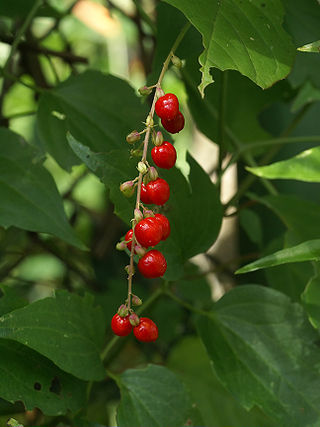
Boraginaceae, the borage or forget-me-notfamily, includes about 2,000 species of shrubs, trees, and herbs in 146 to 156 genera with a worldwide distribution.

Anigozanthos is a genus of Southwest Australian plants of the bloodwort family Haemodoraceae. The 11 species and their subspecies are commonly known as kangaroo paw or catspaw, depending on their size, and the shape and color of their flowers. A further species, previously identified as Anigozanthos fuliginosus, was separated to a monotypic genus as Macropidia fuliginosa.

Episcia is a genus of flowering plants in the African violet family, Gesneriaceae. The ten species it contains are native to the tropical regions of Central and South America. The species are perennial herbaceous plants characterized by a stoloniferous habit, red flowers, and frequently have marked or patterned leaves. Episcias are sometimes called flame violets.

Chamaerops is a genus of flowering plants in the family Arecaceae. It contains only one species, Chamaerops humilis, variously called European fan palm or the Mediterranean dwarf palm. It is one of the most cold-hardy palms and is used in landscaping in temperate climates.

Heliotropium is a genus of flowering plants in the heliotrope family, Heliotropiaceae. There are around 325 species in this almost cosmopolitan genus, which are commonly known as heliotropes. They are highly toxic to dogs and cats.

Heliotropium arboreum is a species of flowering plant in the borage family, Boraginaceae. It is native to tropical Asia including southern China, Madagascar, northern Australia, and most of the atolls and high islands of Micronesia and Polynesia. Common names include velvetleaf soldierbush, tree heliotrope, veloutier, and octopus bush. It is a shrub or small tree typical of littoral zones reaching a height of 3.6 m (12 ft), with a spread of about 5 m (16 ft).

Tournefortia, commonly known as soldierbush, is a genus of flowering plants in the borage family, Boraginaceae.

Tournefortia pubescens is a species of plant in the family Boraginaceae. It is endemic to the Galápagos Islands.
Tournefortia rufosericea is a species of soldierbush plant in the family Boraginaceae. It is endemic to the Galápagos Islands.

Heliotropioideae was a subfamily of the flowering plant family Boraginaceae, comprising roughly 450 species. A 2016 revision of the Boraginales recognises it as a distinct family, Heliotropiaceae.

Rivina humilis is a species of flowering plant in the family Petiveriaceae. It was formerly placed in the pokeweed family, Phytolaccaceae. It can be found in the southern United States, the Caribbean, Central America, and tropical South America. Common names include pigeonberry, rougeplant, baby peppers, bloodberry, and coralito. The specific epithet means "dwarfish" or "lowly" in Latin, referring to the plant's short stature.
T. salicifolia may refer to:
Heliotropiaceae are a cosmopolitan family of flowering plants with approximately 450 species worldwide, though it is concentrated especially in the tropics and subtropics.

Iris humilis is a plant species in the genus Iris, it is also in the subgenus of Iris and in the Psammiris section. It is a rhizomatous perennial, with a wide distribution range from Europe to Russia to China, via Mongolia and Kazakhstan. It has sword-shaped leaves, a short stem and yellow flowers with an orange beard. It is cultivated as an ornamental plant in temperate regions.

Trachycarpeae is a tribe of palms in subfamily Coryphoideae of the plant family Arecaceae. It has the widest distribution of any tribe in Coryphoideae and is found on all continents, though the greatest concentration of species is in Southeast Asia. Trachycarpeae includes palms from both tropical and subtropical zones; the northernmost naturally-occurring palm is a member of this tribe. Several genera can be found in cultivation in temperate areas, for example species of Trachycarpus, Chamaerops, Rhapidophyllum and Washingtonia.

Euploca is an almost cosmopolitan genus of plants with around 100 species. It was first described by Thomas Nuttall in 1837. While part of the broadly defined Boraginaceae in the APG IV system from 2016, a revision of the order Boraginales from the same year includes Euploca in the separate family Heliotropiaceae. Its species used to be classified in the genera Hilgeria and Schleidenia and in Heliotropium sect. Orthostachys, but were found to form an independent lineage in a molecular phylogenetic analysis, more closely related to Myriopus than to Heliotropium. While many species use the C4 photosynthetic pathway, there are also C3–C4 intermediate species. Species have leaves with a C4-typical Kranz anatomy.

Dilkea is a genus of flowering plants belonging to the family Passifloraceae.
Heliotropium strictum can refer to:













